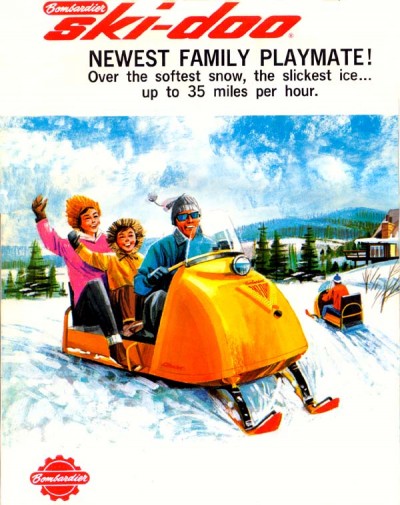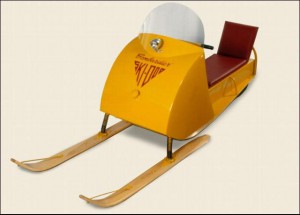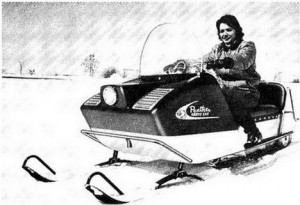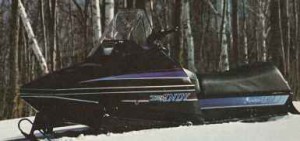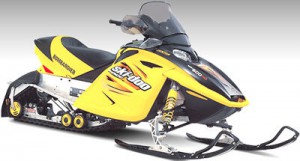Welcome to the first installment of our feature series “Vintage Sled.” This will be a regular feature next winter joining the “Trail In Focus” and “Destination” articles along with the latest snow conditions, ride recaps and whatever else comes across our 2-stroke exhaust saturated minds. For this feature, I will be highlighting random vintage sleds for random reasons- could one of your old sleds be featured? Tune in to find out.
Being an ex history major I feel that it is important to know where we came from in order to better understand where we are going. The history of snowmobiling is a fascinating one and I continue to be blown away by the huge leaps forward in technology that the sport takes on an almost yearly basis. This may be one of the reasons that vintage snowmobile shows have become so popular- despite the nostalgia of looking at the wide variety of sleds that existed during snowmobiling’s first golden age, you can also see some important milestones in snowmobile development. Here are just a few things that we take for granted now but at the time of their inception were cutting edge technology.
1. The “modern” snowmobile.
Yes, there were snow traveling vehicles before the first Ski-Doo hit the snow but nothing that looked like this. The first Ski-Doo served as a template of how snowmobiles should be built: engine in the front with a clutch and drive belt system powering an endless rubber track and two skis in front to steer with. The Ski-Doo was so successful and dominated the market so thoroughly that other snowmobile manufacturers were forced to copy Bombardier’s design. Although technology has advanced dramatically over the past 55 years, the basic concept dreamed up in Joseph-Armand Bombardier’s mind has not changed.
2. Slide rail Suspension.
When Arctic Cat rolled out the first slide rail suspension in 1967 on the Arctic Cat Panther there were many people that wondered how two metal runners could provide a better ride than bogey wheels. Multiple sets of bogey wheels had been the only way to support a track and now Arctic Cat had to convince us that not only was a slide rail a better way to support a track but that it provided a more consistent and comfortable ride as well. Just like the first Ski-Doo, Arctic Cat’s suspension proved to be so successful that eventually all of the other manufacturers were forced to follow their lead and Arctic Cat shocked the execs at Bombardier by riding the slide rail suspension to market dominance by the mid 70′s.
3. Independent Front Suspension.
A product of the racetrack and an idea that had been toyed with by other manufacturers in multiple forms with various degrees of success was finally perfected by Polaris and confidently brought to the consumer market with their 1980 TX-L Indy. Like most new innovations, the Indy had its share of naysayers. Critics were convinced that the trailing arm was just too odd looking and that it could easily fall victim to rocks and stumps. Luckily for Polaris, critics and competitors do not make the buying decisions- consumers do, and once the snowmobiling public experienced the Indy’s vastly superior ride quality, they flocked to Polaris in droves and Indy’s flew out the door as fast as Polaris could make them. The groundbreaking front suspension of the Indy combined with the growing organized trail systems in Canada and the US launched snowmobiling into its second golden age in the 90′s. Polaris enjoyed market dominance for over a decade making the Indy the best selling snowmobile model in history. While Polaris was riding high, the other manufacturers scrambled to catch up, working on multiple IFS designs of their own. Arctic Cat held fast on its A arm suspension eventually perfecting it and the A arm has since replaced the trailing arm in all of today’s sleds.
4. Rider Forward.
The running theme here is sleds that bring something to the market that forces everyone else to follow suit. Ski-Doo did just that in 2003 with its MXZ on the new rev chassis. As with the slide rail and the trailing arm, the Rev Chassis was met with a huge up swell of resistance. It looked way too funky for traditionalists and when you sat on it in the showroom it felt more like a motorcycle than a snowmobile. The other manufacturers scoffed at the radical Ski-Doo design, content to keep punching out the tried and true traditional looking sleds. Just like the aforementioned Indy, however, the Rev chassis proved its worth on the trail, delivering a ride that was beyond compare and far beyond the capabilities of the old design. Overnight Ski-Doo catapulted to the top of the market leaving the other manufacturers in shell shock and scrambling to catch up.
What new innovation will be next? What groundbreaking technology will usher in the next chapter of snowmobiling? Only time will tell, and someday even the technologically advanced sleds of today will have the “Vintage” tag on them.
